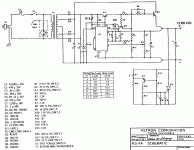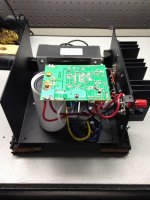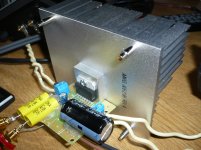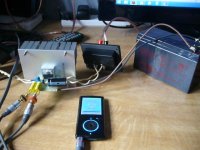I made one with the help of Danielwritesbac. Separate ps rails for each channel.
He's testing it at the moment as far as I know.
For me it worked great!
Nice looking TDA7297 amp board. Do you plan to offer a group buy for it?
I might but depending on the interested parties it might make more sense that someone from US takes care of it. At the moment I do have about 5 or 6 pcbs left. I'm waiting for Daniels feedback on it before I offer them as there were some people some time ago voicing concerns over the "untested" design. So I made a minimum order for myself 
I might but depending on the interested parties it might make more sense that someone from US takes care of it. At the moment I do have about 5 or 6 pcbs left. I'm waiting for Daniels feedback on it before I offer them as there were some people some time ago voicing concerns over the "untested" design. So I made a minimum order for myself
I would be willing to evaluate it against my tube amplifiers and my modified TPA3116 Class D amps. Please PM me if you are interested.
Just so you guys know, a chip from mouser played many albums at 23v, at my place.
A chip from china? I had them blow up every time something turned on in my place if they were running more than 16v from any sort of PSU.
I'm only running my $3 China at 16.4v, regulated, but I've been running mine for quite some time (often for tens of hours at a time) and frequently at volumes high enough to get the chip temperature up within 10C of the defined max.
Ticking right along, sounding great, right now. Maybe you should arrange for an electrical inspection.
Ticking right along, sounding great, right now. Maybe you should arrange for an electrical inspection.
Destroyer OS made me a believer of the TDA7297 when he recommended increasing the input capacitance from the stock 0.22uF up to 1uF. This reduced the cut-off frequency to significantly improve bass response. I recommended the same to a buddy across the country who also shelved his TDA7297 amp in favor of the TPA3116 amps. He installed the 1uF Radio Shack metallized Polyester film caps (272-1055) that has received good reviews on a T-amp thread here at diyAudio.com:
http://www.diyaudio.com/forums/class-d/101344-tripath-input-coupling-caps-8.html#post1326230
Like me, he uses a modified Astron RS-12A regulated linear power supply with a low ESR 22,000uF Kemet (Rifa) PEH200 electrolytic filter cap and some additional Panasonic FM electrolytic filter caps. My power supply is set to 14VDC output.
We both agree that the TDA7297 has greater presence and better bass response than the TPA3116 amps that we've modded. Connected to my analog rig consisting of an upgraded Kenwood Trio PC-400U belt-idler wheel drive turntable and Audio Research PH5 phono stage, I have a highly musical system. I'm. Sure I can get way with this low powered amp, because my modified Klipsch Forte II speakers are 98dB sensitive.
My PH5 phono stage is a two stage JFET/6922 vacuum tube amp that creates a huge and deep soundstage with my TDA7297 amp.
Destroyer OS made me a believer of the TDA7297 when he recommended increasing the input capacitance from the stock 0.22uF up to 1uF. This reduced the cut-off frequency to significantly improve bass response. I recommended the same to a buddy across the country who also shelved his TDA7297 amp in favor of the TPA3116 amps. He installed the 1uF Radio Shack metallized Polyester film caps (272-1055) that has received good reviews on a T-amp thread here at diyAudio.com:
http://www.diyaudio.com/forums/class-d/101344-tripath-input-coupling-caps-8.html#post1326230
Like me, he uses a modified Astron RS-12A regulated linear power supply with a low ESR 22,000uF Kemet (Rifa) PEH200 electrolytic filter cap and some additional Panasonic FM electrolytic filter caps. My power supply is set to 14VDC output.
We both agree that the TDA7297 has greater presence and better bass response than the TPA3116 amps that we've modded. Connected to my analog rig consisting of an upgraded Kenwood Trio PC-400U belt-idler wheel drive turntable and Audio Research PH5 phono stage, I have a highly musical system. I'm. Sure I can get way with this low powered amp, because my modified Klipsch Forte II speakers are 98dB sensitive.
My PH5 phono stage is a two stage JFET/6922 vacuum tube amp that creates a huge and deep soundstage with my TDA7297 amp.
While I'm not really sure where this is going, I'll try to address the above with a few simple statements
- I've repeatedly said that I think the 7297 is incredible
- I've taken advice in this thread (including that of Destroyer OS) and installed 1uF input caps and upgraded the power tank to 30,000uF - the amp would fool anyone into thinking it is MUCH bigger than it is
- For $3, there is no better amp. Hell, for $20 there is no better amp, IMO.
- I still like my EL34 P-P tube amp better (especially now that I have converted it from UL to triode)
- I'm still very interested in trying other amps - you must be as well, as I see we both have Wiener's destined for our doorsteps
- My crack about Destroyer OS's electrical system was merely a joke - I can't figure out how he is "smoking" so many chips while running them under spec voltage - as I have said, I am running a "reject" $3 one at 16.4v continuously and quite loud and it just keeps ticking.
- The statement immediately above does not mean to suggest that I am discounting the superiority of proper samples from appropriate sources.
- Beyond anything else, I am in this for the fun.
I hope this is all clear now. If there is any doubt, please ask for clarification.
Wasn't challenging anything you said. I am in more agreement with you and just shared my own recent experiences. I agree that these amps sound stupid good for the money. Like you, I prefer my modified/restored Dynakit Stereo 35 EL84 P-P amp over the TDA7297 and TPA3116 amps. Perhaps, some troll has got you a little defensive.
Wasn't challenging anything you said. I am in more agreement with you and just shared my own recent experiences. I agree that these amps sound stupid good for the money. Like you, I prefer my modified/restored Dynakit Stereo 35 EL84 P-P amp over the TDA7297 and TPA3116 amps. Perhaps, some troll has got you a little defensive.
Understood.
And yes, it's just too easy for things to be misinterpreted on the internet. I am not imune to it. No hard feelings?
Like me, he uses a modified Astron RS-12A regulated linear power supply with a low ESR 22,000uF Kemet (Rifa) PEH200 electrolytic filter cap and some additional Panasonic FM electrolytic filter caps. My power supply is set to 14VDC output.
How did you get the cover off the Astron. I removed all 6 screws (2 on top, 4 on bottom), but the cover will not slide off. Is there a trick I'm missing?
Thanks, Mike
How did you get the cover off the Astron. I removed all 6 screws (2 on top, 4 on bottom), but the cover will not slide off. Is there a trick I'm missing?
Thanks, Mike
is there a suggested mod for Astron RS-7a, I am using it to drive 7297...
is there a suggested mod for Astron RS-7a, I am using it to drive 7297...
I reference the Astron Power Supply Index:
Astron Power Supply Index Page
This Website has a wealth of information including schematics for many Astron power supplies including the RS-7A. There are many modification and troubleshooting tips there.

According to the above schematic, I would recommend upgrading the following electrolytic caps:
C1 - 42,000uF/25V (Evox-Rifa or Kemet PEH200)
C2 - 470uF/35V (Panasonic FM, Nichicon HE, or Nichicon KZ)
C7 - 2,200uF/16V (Panasonic FM, Nichicon HE, or Nichicon KZ)
I also added a 0.1uF/275V Wima MKP X2-rated Polypropylene film cap across the contact terminals on the AC SPST power switch.
I am not completely familiar with the Astron RS-7A's physical layout, so you would need to insure that all your replacement components properly fit within the enclosure and can be securely mounted.

In the case of modifying a brand new Astron RS-12A, I drilled a hole in the bottom of the chassis to accommodate the M12 mounting stud on the large, white Kemet (Rifa) PEH200 electrolytic filter cap to anchor it and the attached regulator board. I also added some Teflon sheet to the interior surface of the top panel to avoid any potential shorts from the top panel making contact with the regulator board.
I would only recommend doing this if you are familiar with working with high voltages, and power supplies including proper capacitor draining.
For the DC power cable connecting the power supply output to my amps, I used a twisted pair of 16AWG Teflon-insulated Silver-plated Copper stranded Mil Spec wire jacketed in spiral wrap tubing and Tech Flex sleeving. I use either Neutrik 4-pin XLR or Switchcraft S760 DC power connector.
Making these changes on my "new to me" used Astron RS-12A (ca. 1980's) and on a buddy's brand new Astron RS-12A (2013), the improvement was night and day each step of the way going from a cheap SMPS brick to a stock Astron RS-12A to a modified Astron RS-12A. We did comparisons and each improvement resulted in growth of the soundstage, improved separation of performers, improved tonality including deeper bass response. Another friend across the country bought an Astron RS-12A and did the same mods. He heard the same improvements.
I also added some 3M Dynamat vibration-damping sheet material from a local auto parts store to the interior walls of the top and side enclosure panels of my vintage unit, because my unit had a mechanical hum originating from the power transformer. This makes it a bit more challenging to remove and replace the top/side cover, but I've been able to manage without scratching the finish.
Last edited:
Thanks for the schematic.
I got a RS-12A on Ebay for $25.00 shipped, but it's only putting out 12.4 volts.
I thought there was a pot inside to adjust the voltage, but I don't see one in the schematic.
The second RS-12A I bought at a local 2nd hand tools shop ($19.99) is putting out 18.3 volts. I'm trying to get the lid off that one to see how the mod was done.
18.3 volts is nice powering a TPA3116 amp.
Mike
I got a RS-12A on Ebay for $25.00 shipped, but it's only putting out 12.4 volts.
I thought there was a pot inside to adjust the voltage, but I don't see one in the schematic.
The second RS-12A I bought at a local 2nd hand tools shop ($19.99) is putting out 18.3 volts. I'm trying to get the lid off that one to see how the mod was done.
18.3 volts is nice powering a TPA3116 amp.
Mike
The pot for adjusting the output voltage is located on the regulator PCB. I recommend using a plastic screwdriver if you do not have clear access to it.
To be clear, the stock Astron units do sound good with these amps and the TPA311x Class D amps. However, making some upgrades really improves the sound quality further. This is most noticeable with complex, loud passages with large orchestral music and even with some rock music that really taps out the amplifier headroom. I keep my output at 14VDC for my TDA7297 and TPA311x amps. My TDA7297 heat sink gets a little warm, but not hot at all. The same applies to my TPA311x amps.
I am sure that there are some really nice scratch-built power supplies, but I took the lazy route and got my Astron RS-12A locally through Craigslist from a guy who was only 1 mile away from my workplace.
To be clear, the stock Astron units do sound good with these amps and the TPA311x Class D amps. However, making some upgrades really improves the sound quality further. This is most noticeable with complex, loud passages with large orchestral music and even with some rock music that really taps out the amplifier headroom. I keep my output at 14VDC for my TDA7297 and TPA311x amps. My TDA7297 heat sink gets a little warm, but not hot at all. The same applies to my TPA311x amps.
I am sure that there are some really nice scratch-built power supplies, but I took the lazy route and got my Astron RS-12A locally through Craigslist from a guy who was only 1 mile away from my workplace.
- Home
- Amplifiers
- Chip Amps
- What the heck? It's less than lunch!

